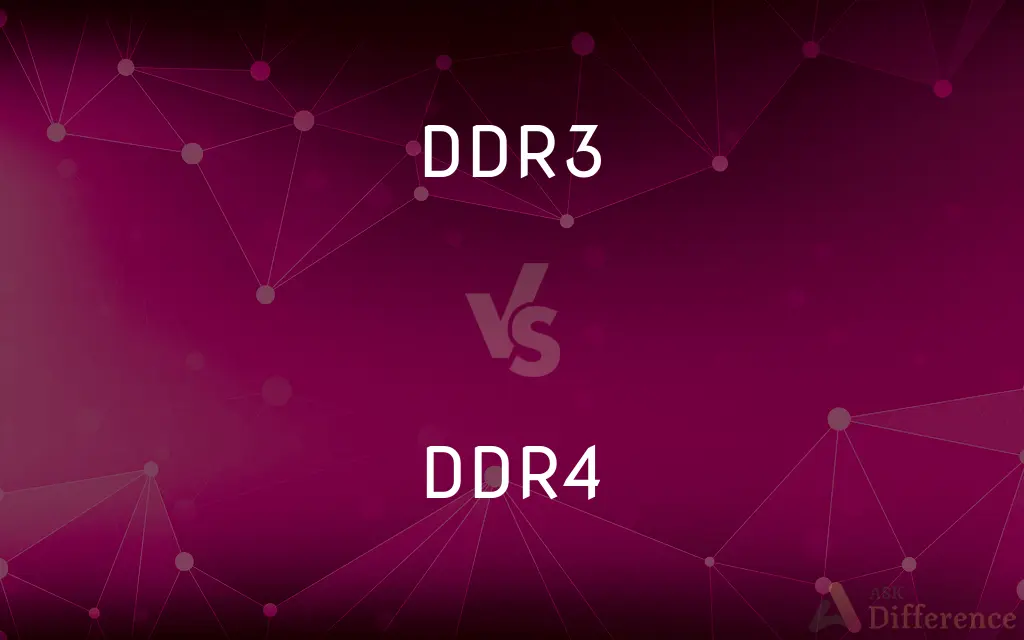DDR3 vs. DDR4 — What's the Difference?
By Tayyaba Rehman — Published on October 27, 2023
DDR3 and DDR4 are versions of DRAM memory, with DDR4 having improvements in speed, size, power consumption, and overall performance compared to DDR3.

Difference Between DDR3 and DDR4
Table of Contents
ADVERTISEMENT
Key Differences
When examining DDR3 and DDR4, distinctive variations, particularly in aspects of performance, power consumption, and physical design, become markedly apparent. DDR3, denoting "Double Data Rate Type Three," has been a stalwart in memory technology for numerous electronic devices, providing a balance of speed, cost, and power for years. Conversely, DDR4, or "Double Data Rate Type Four," emerges as a superior successor, encompassing advancements in data rate speed, memory storage capacity, and even reduced power usage, hence offering a more optimized memory solution in contemporary technological contexts.
Delving into the sphere of data transfer speed, DDR3 provides a commendable performance but is palpably overshadowed by the robust data transfer rates offered by DDR4. DDR3 facilitates data rates between 800 MT/s (MT/s represents Million Transfers per second) and 2133 MT/s, maintaining adequate for many applications during its peak usage. On the other side, DDR4 propels the data transfer rates further, commencing at 2133 MT/s and potentially soaring to 4266 MT/s or beyond, thus making DDR4 a decisively faster alternative, especially in tasks demanding higher bandwidth and speed.
In the realm of power consumption, DDR3 and DDR4 again display noteworthy disparities, crucially impacting device efficiency and thermal management. DDR3 typically operates at a voltage of 1.5V, maintaining a balance between energy usage and performance that was deemed optimal during its era of dominance. DDR4, however, manages to perform its enhanced functions at a reduced operating voltage of 1.2V, effectively enabling higher performance while simultaneously consuming less power, which is especially pivotal in battery-dependent devices like laptops and tablets.
Observing their physical architecture, DDR3 and DDR4 manifest visible distinctions in pin configuration and compatibility. DDR3 RAM modules are equipped with 240 pins for desktop memory (DIMMs) and 204 pins for laptop memory (SODIMMs), ensuring compatibility with DDR3-supporting motherboards. In contrast, DDR4 introduces a different pin configuration, featuring 288 pins for desktop DIMMs and 260 pins for SODIMMs, thereby negating physical compatibility with DDR3 slots and underscoring that DDR4 RAM cannot be used interchangeably with DDR3 RAM slots.
DDR3 and DDR4 thus punctuate two significant eras in memory technology, each respectively shaping and enhancing the capabilities and performances of the devices they inhabit. DDR3, while no longer the foremost choice for new technology, still pervades numerous devices, illustrating a resilient presence in the tech world. DDR4, nonetheless, is actively phasing out DDR3 in modern devices by virtue of its superior speed, improved efficiency, and advanced technology, laying the foundation for the imminent arrival of its successor, DDR5, thereby perpetuating the cycle of technological evolution.
ADVERTISEMENT
Comparison Chart
Data Rate
800 MT/s to 2133 MT/s
2133 MT/s to 4266 MT/s or more
Operating Voltage
1.5V
1.2V
Pin Configuration (DIMMs)
240 pins
288 pins
Pin Configuration (SODIMMs)
204 pins
260 pins
Initial Release Year
2007
2014
Compare with Definitions
DDR3
Provides data rates from 800 MT/s to 2133 MT/s.
My DDR3 RAM operates at a data rate of 1600 MT/s.
DDR4
An advanced, faster version of Synchronous Dynamic Random-Access Memory.
My gaming rig operates smoothly with DDR4 memory.
DDR3
Operates at a higher voltage compared to newer models.
DDR3 consumes more power with its 1.5V operation.
DDR4
Currently represents a prevalent memory type in modern devices.
Most of the latest devices are now being equipped with DDR4 memory.
DDR3
A type of Synchronous Dynamic Random-Access Memory.
My computer is still using DDR3 memory.
DDR4
Operates at a lower voltage, enhancing energy efficiency.
DDR4, with its 1.2V operation, consumes less power than its predecessor.
DDR3
Incorporates a different pin configuration than its successors.
Ensure the motherboard supports DDR3's 240-pin DIMMs.
DDR4
Showcases enhanced speed with data rates starting at 2133 MT/s.
This high-performance task benefits significantly from DDR4's impressive data rates.
DDR3
Is less energy-efficient than its successors.
The device uses DDR3, which isn’t as power-efficient as newer memory types.
DDR4
Features a distinct pin configuration, ensuring specific motherboard compatibility.
Before purchasing, I verified that the motherboard is compatible with DDR4's 288-pin DIMMs.
Common Curiosities
Can DDR3 and DDR4 memory be used interchangeably on the same motherboard?
No, DDR3 and DDR4 have different pin configurations and are not physically compatible.
Which operates at a lower voltage, DDR3 or DDR4?
DDR4 operates at a lower voltage than DDR3.
What does DDR3 stand for?
Double Data Rate Type Three.
What does DDR4 stand for?
Double Data Rate Type Four.
Which memory type, DDR3 or DDR4, offers higher data transfer speeds?
DDR4 generally offers higher data transfer speeds than DDR3.
Are DDR3 and DDR4 physically different in terms of pin configuration?
Yes, DDR3 and DDR4 have different pin configurations, ensuring specific motherboard compatibility.
Which is generally more expensive, DDR3 or DDR4?
Prices fluctuate, but generally, DDR4 can be more expensive due to its advanced features.
Can DDR4 fit into a DDR3 RAM slot?
No, due to the different pin configurations, DDR4 cannot fit into a DDR3 RAM slot.
When were DDR3 and DDR4 initially released?
DDR3 was released in 2007, while DDR4 was released in 2014.
Is DDR3 memory still used in modern computers?
DDR3 is less common in new computers but is still used in some older or budget models.
Will computers with DDR3 memory still be adequate for basic tasks?
Yes, DDR3 memory can still be adequate for basic tasks like browsing and document editing.
Does DDR4 offer any advantage in energy consumption over DDR3?
Yes, DDR4 consumes less power than DDR3, operating at 1.2V compared to DDR3’s 1.5V.
Are DDR3 and DDR4 SODIMMs physically different?
Yes, DDR3 SODIMMs have 204 pins, while DDR4 SODIMMs have 260 pins.
Can DDR3 and DDR4 memory modules be mixed in the same computer?
No, a motherboard will support either DDR3 or DDR4, not both, preventing mixing of the two types.
Does DDR4 offer advantages in gaming compared to DDR3?
Yes, DDR4’s enhanced speeds and efficiency can offer improved gaming performance compared to DDR3.
Share Your Discovery

Previous Comparison
Latino vs. Mexican
Next Comparison
Quid vs. ShillingAuthor Spotlight
Written by
Tayyaba RehmanTayyaba Rehman is a distinguished writer, currently serving as a primary contributor to askdifference.com. As a researcher in semantics and etymology, Tayyaba's passion for the complexity of languages and their distinctions has found a perfect home on the platform. Tayyaba delves into the intricacies of language, distinguishing between commonly confused words and phrases, thereby providing clarity for readers worldwide.
















































